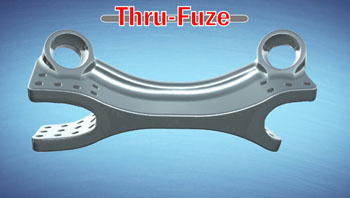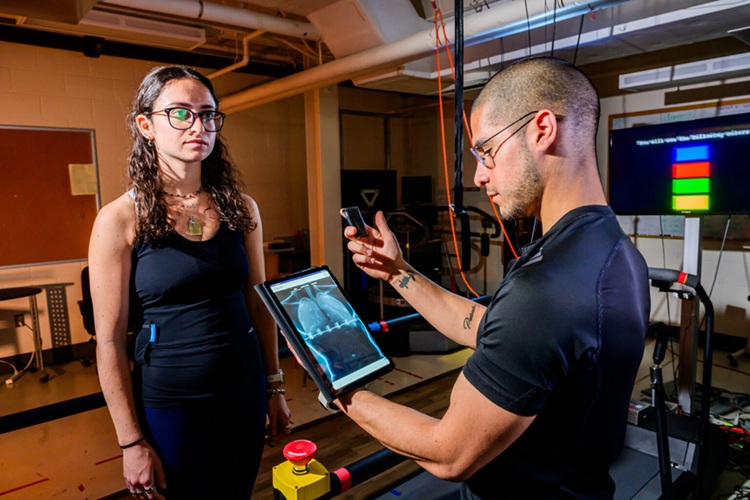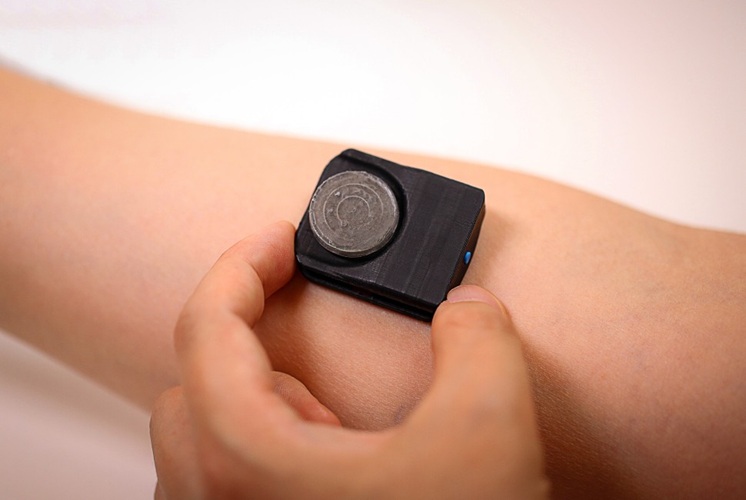Innovative Fusion Device Could Revolutionize Back Surgery 
|
By HospiMedica International staff writers Posted on 29 Dec 2015 |

Image: The Thru–Fuze device (Photo courtesy of USNW).
A new spinal fusion device designed to reduce chronic back pain could negate the need for invasive surgery and bone grafts.
Under development by researchers at the University of New South Wales (UNSW; Sydney, Australia) the Thru–Fuze device is made of porous titanium that promotes bone growth and fusion both on and through the device after it is placed between the vertebrae. Over time, the device acts as a bridge between adjacent vertebrae for additional bone growth, resulting in rapid biomechanical fixation, without the need for a bone graft procedure or supporting metallic hardware.
According to the researchers, the device will allow faster, simpler surgery with minimal radiation exposure compared to current methods. Preclinical and laboratory testing in animal models has demonstrated rapid biomechanical fixation between the fusion device and the vertebrae. Human trials of the Thru-Fuze are expected to begin at the Prince of Wales Hospital (Sydney, NSW, Australia) in late 2016, with future commercialization of the device exclusively licensed to Intellectual Ventures (Bellvue, WA, USA). Patents for the technology have been filed in Australia, Europe, China, and the United States.
“Existing methods of spinal fusion use rod or cage systems that require screws to be drilled into the spine and a painful bone graft harvested, which is the material used to form the bridge and obtain the fusion between the vertebrae in the spine,” said device inventor Prof. Bill Walsh, MD, director of surgical and orthopedic laboratories at UNSW. “These systems are very costly, difficult and time consuming to implant and they also have variable rates of fusion success. Existing methods rely on the bone to make its way right across the vertebrae and it can take up to a year to find out if the surgery has been a success.”
“New technologies such as the Thru-Fuze are of paramount importance, as surgeons strive to deliver better patient outcomes with less invasive and more effective implant and prostheses options,” said neurosurgeon Ralph Mobbs, MD, who will lead the human trials. “The potential of the device is significant.”
Related Links:
University of New South Wales
Intellectual Ventures
Under development by researchers at the University of New South Wales (UNSW; Sydney, Australia) the Thru–Fuze device is made of porous titanium that promotes bone growth and fusion both on and through the device after it is placed between the vertebrae. Over time, the device acts as a bridge between adjacent vertebrae for additional bone growth, resulting in rapid biomechanical fixation, without the need for a bone graft procedure or supporting metallic hardware.
According to the researchers, the device will allow faster, simpler surgery with minimal radiation exposure compared to current methods. Preclinical and laboratory testing in animal models has demonstrated rapid biomechanical fixation between the fusion device and the vertebrae. Human trials of the Thru-Fuze are expected to begin at the Prince of Wales Hospital (Sydney, NSW, Australia) in late 2016, with future commercialization of the device exclusively licensed to Intellectual Ventures (Bellvue, WA, USA). Patents for the technology have been filed in Australia, Europe, China, and the United States.
“Existing methods of spinal fusion use rod or cage systems that require screws to be drilled into the spine and a painful bone graft harvested, which is the material used to form the bridge and obtain the fusion between the vertebrae in the spine,” said device inventor Prof. Bill Walsh, MD, director of surgical and orthopedic laboratories at UNSW. “These systems are very costly, difficult and time consuming to implant and they also have variable rates of fusion success. Existing methods rely on the bone to make its way right across the vertebrae and it can take up to a year to find out if the surgery has been a success.”
“New technologies such as the Thru-Fuze are of paramount importance, as surgeons strive to deliver better patient outcomes with less invasive and more effective implant and prostheses options,” said neurosurgeon Ralph Mobbs, MD, who will lead the human trials. “The potential of the device is significant.”
Related Links:
University of New South Wales
Intellectual Ventures
Latest Surgical Techniques News
- Intravascular Imaging for Guiding Stent Implantation Ensures Safer Stenting Procedures
- World's First AI Surgical Guidance Platform Allows Surgeons to Measure Success in Real-Time
- AI-Generated Synthetic Scarred Hearts Aid Atrial Fibrillation Treatment
- New Class of Bioadhesives to Connect Human Tissues to Long-Term Medical Implants
- New Transcatheter Valve Found Safe and Effective for Treating Aortic Regurgitation
- Minimally Invasive Valve Repair Reduces Hospitalizations in Severe Tricuspid Regurgitation Patients
- Tiny Robotic Tools Powered by Magnetic Fields to Enable Minimally Invasive Brain Surgery
- Magnetic Tweezers Make Robotic Surgery Safer and More Precise
- AI-Powered Surgical Planning Tool Improves Pre-Op Planning
- Novel Sensing System Restores Missing Sense of Touch in Minimally Invasive Surgery
- Headset-Based AR Navigation System Improves EVD Placement
- Higher Electrode Density Improves Epilepsy Surgery by Pinpointing Where Seizures Begin
- Open-Source Tool Optimizes Placement of Visual Brain Implants
- Easy-To-Apply Gel Could Prevent Formation of Post-Surgical Abdominal Adhesions
- Groundbreaking Leadless Pacemaker to Prevent Invasive Surgeries for Children
- Spectroscopy Technique Improves Surgery for Pediatric Epilepsy Patients
Channels
Critical Care
view channel
Novel Intrabronchial Method Delivers Cell Therapies in Critically Ill Patients on External Lung Support
Until now, administering cell therapies to patients on extracorporeal membrane oxygenation (ECMO)—a life-support system typically used for severe lung failure—has been nearly impossible.... Read more
Generative AI Technology Detects Heart Disease Earlier Than Conventional Methods
Detecting heart dysfunction early using cost-effective and widely accessible tools like electrocardiograms (ECGs) and efficiently directing the right patients for more expensive imaging tests remains a... Read more
Wearable Technology Predicts Cardiovascular Risk by Continuously Monitoring Heart Rate Recovery
The heart's response to physical activity is a vital early indicator of changes in health, particularly in cardiovascular function and mortality. Extensive research has demonstrated a connection between... Read more
Wearable Health Monitoring Device Measures Gases Emitted from and Absorbed by Skin
The skin plays a vital role in protecting our body from external elements. A key component of this protective function is the skin barrier, which consists of tightly woven proteins and fats that help retain... Read morePatient Care
view channel
Portable Biosensor Platform to Reduce Hospital-Acquired Infections
Approximately 4 million patients in the European Union acquire healthcare-associated infections (HAIs) or nosocomial infections each year, with around 37,000 deaths directly resulting from these infections,... Read moreFirst-Of-Its-Kind Portable Germicidal Light Technology Disinfects High-Touch Clinical Surfaces in Seconds
Reducing healthcare-acquired infections (HAIs) remains a pressing issue within global healthcare systems. In the United States alone, 1.7 million patients contract HAIs annually, leading to approximately... Read more
Surgical Capacity Optimization Solution Helps Hospitals Boost OR Utilization
An innovative solution has the capability to transform surgical capacity utilization by targeting the root cause of surgical block time inefficiencies. Fujitsu Limited’s (Tokyo, Japan) Surgical Capacity... Read more
Game-Changing Innovation in Surgical Instrument Sterilization Significantly Improves OR Throughput
A groundbreaking innovation enables hospitals to significantly improve instrument processing time and throughput in operating rooms (ORs) and sterile processing departments. Turbett Surgical, Inc.... Read moreHealth IT
view channel
Printable Molecule-Selective Nanoparticles Enable Mass Production of Wearable Biosensors
The future of medicine is likely to focus on the personalization of healthcare—understanding exactly what an individual requires and delivering the appropriate combination of nutrients, metabolites, and... Read more
Smartwatches Could Detect Congestive Heart Failure
Diagnosing congestive heart failure (CHF) typically requires expensive and time-consuming imaging techniques like echocardiography, also known as cardiac ultrasound. Previously, detecting CHF by analyzing... Read moreBusiness
view channel
Expanded Collaboration to Transform OR Technology Through AI and Automation
The expansion of an existing collaboration between three leading companies aims to develop artificial intelligence (AI)-driven solutions for smart operating rooms with sophisticated monitoring and automation.... Read more















